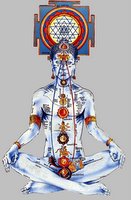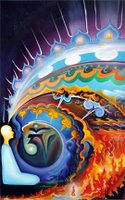
ANCIENT EASTERN HEALING TRADITION
IN A MODERN WESTERN WORLD
by Lidia Becker, from a presentation given on 28 March 2006
Eastern and Western medicine are usually seen as two completely different entities. However, most historians agree that Western medicine shared many of the naturalistic and element-oriented concepts commonly associated with Eastern medicine. The world’s greatest healing traditions evolved as a reflection of the spiritual and philosophical practices of their native cultures. Nevertheless, in the seventeenth century Western medicine rapidly departed down the road of rationalism and science.Western medicine is based upon the study of body structures, scientific observation, and the analysis of achieved results. It views the body as a structure made up of various major systems such as the nervous system, circulatory system, skeletal system etc.
Traditional Eastern medicine is deeply rooted in ancient philosophical systems and views the body in an entirely different manner. In traditional Eastern medicine, there is only a general concern for anatomical structure. For example, there is no concept of a nervous system, and only a general concern for anatomical structure. The human body is seen as a complex of life-sustaining processes, preserved and nourished by the circulation of essential fluids and vital energy.
According to the medical traditions of China, Korea and Japan, the human body is a network of meridians, which are paths for distributing vital energy called Qi or Chi to specific areas of the body. Small external points located along these paths are commonly called acupoints, which can be used to regulate flow of Qi. Acupoints are treated by massage (acupressure), acupuncture or other healing procedures, in an effort to maintain and restore health. These same points play a significant role in martial arts.
A similar concept is reflected in Indian disciplines such as Ayurvedic medicine and yoga, according to which the human body comprises seven major energy centres called chakras (see image above). The vital energy, called Prana (the same as Qi) circulates throughout the body. The chakras are connected with body organs and related to certain emotional and intellectual aspects.
For example, if the flow of energy is disturbed in the area of a third chakra or stomach chakra, a person may have stomach complaints. However, as the very same chakra is seen as the centre of a person’s will, it is believed that the energy block is likely to have been created by a certain event or condition. For example, a person may have been forced to do something against his/her will; or a person may be insecure and cannot really decide what he/she wants in his/her life; or he/she simply cannot stand up for his/her rights etc.
The theory that there is a strong connection between physical diseases and emotional traumas resulting from past events and self-beliefs (the beliefs one has about oneself or about life), has been used over the past few decades in a newly developed alternative or holistic medicine in the West. Though not scientifically recognised, many agree that it has more success with chronic, degenerative diseases, addictive behaviour and stress-related conditions than classic Western medicine, which has made great advances in treating critical illnesses and infections.
But how do you really heal yourself? Is it some kind of magic? The experienced therapists claim that all you need is a technique and a good will. The body does the work for you. Many techniques are based on the following procedure: by focusing your attention on a troubled part of the body and using your intuition, you discover an event from the past and related emotions that were pushed aside. You set the memory free, experience it again and then begin a process of forgiveness towards any involved person or yourself.
Admitting fault, forgiveness and gratitude are basic healing tools. According to most teachers, you cannot heal yourself if you give refuge to anger, hatred, guilt, jealousy or fear. The treatment is completed when you have reprogrammed your memory, created positive thoughts for the future and visualised yourself successfully resolving any similar future situation.
Breathing exercises are also considered a powerful instrument in preventing and healing diseases. Being an essential part of yoga, controlled breathing also regulates the flow of vital life energy. It is believed that the ability of mastering breath brings one closer to mastering mind.
Breathing techniques differ depending on the results desired. For example, the following type of breathing promotes calmness and relaxation: breath deeply into your stomach and make it round (4 seconds); hold your breath for a moment; then exhale very slowly (8 seconds) by pulling your stomach in at the same time. To accelerate the healing process, you need to imagine that your breath goes through the part of the body that needs to be treated. It is believed that such breathi
 ng helps to remove the blockage and re-establishes a healthy flow of energy.
ng helps to remove the blockage and re-establishes a healthy flow of energy.Another effective breathing technique is simulation of running a long distance. In this exercise, breathing is one continuous flow without pauses between inhaling and exhaling. It is claimed that such breathing exercise enables the release of emotions and energy blocks. It can last between several and forty-five minutes. However, it is advised that it be performed in the presence of an experienced person who would guide a patient through the process.
Today in China, Korea and Japan Western medicine is successfully integrated into the system of traditional medicine. On the other hand, some western medical institutions are also showing the tendency to incorporate many procedures of eastern medicine into clinical practice. Perhaps we are beginning to see the first steps of a homogenous, interdisciplinary approach in which both theories are freely intermingled .



No comments:
Post a Comment